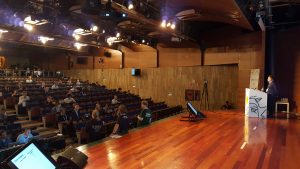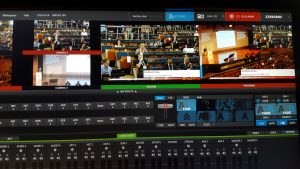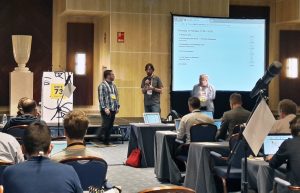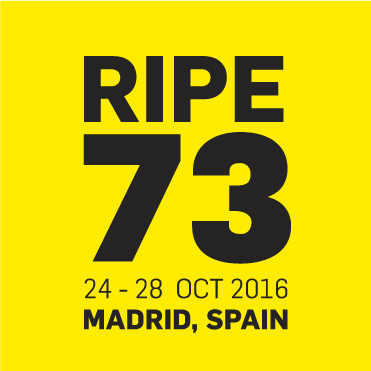- Monday, 24 October
- Tuesday, 25 October
- Wednesday, 26 October
- Thursday, 27 October
- Friday, 28 October
Monday, 24 October
RIPE 73 kicked-off in a wet and rainy Madrid with 491 attendees checked in. In the morning, there were two tutorials (network automation and RIPE Database tips and tricks), followed by a newcomers session to help RIPE Meeting first-timers get up to speed on all things RIPE and the RIPE NCC.
After the welcome remarks from the RIPE Chair and the hosts of the meeting, the Opening Plenary focused on analysis. Jordi Palet Martinez shared the results of his worldwide survey of IPv6 deployment. He was followed by Philip Richter, a RACI recipient, who presented on the results of his study using BitTorrent data to uncover the prevalence of Carrier Grade NAT deployments. Shane Kerr ended the session with a lightning talk that looked at the diversity of gender at RIPE Meetings. He asked if the RIPE Meetings should be doing more to beat the industry average for female participation.
The next session started with a presentation from the RIPE NCC’s Athina Fragkouli who highlighted how RIPE has repeatedly been held up as an example of an accountable and effective community in Internet governance circles. However, she cautioned that RIPE couldn’t rest on its laurels. Ioana Livadariu, another RACI candidate, presented on IPv4 transfer markets – concluding that they were growing in size, that most blocks being transferred were legacy, and that the market seemed to be serving its intended purpose (buyers tended to “use” the address space).
The session was then wrapped-up with three lightning talks. Geoff Huston prompted attendees to think about deploying elliptic curve cryptography to improve the security of Internet transactions such as banking. He said this enabled people to take full responsibility for security rather than relying on other parties. Vasileios Glotsas then gave a quick presentation to inform the community about PERISCOPE and asked for feedback. Finally, Roy Arends from ICANN presented on the upcoming rollover of the Root Zone DNSSEC Key Signing Key.
This was followed by the Best Current Operational Practices (BCOP) Task Force session.
And with that, the first day of RIPE 73 came to a close. A planned social gave attendees a chance to meet with the RIPE NCC Executive Board and this was followed by the RIPE 73 Welcome Social.
Tuesday, 25 October
Day two of RIPE 73 began with 571 attendees checked in and several presentations on some interesting academic research. The first three presenters, all from the Twente University (UTwente), reported on their work looking at the effectiveness of anycasting as a mechanism to increase the robustness of root DNS services. Their studies showed that anycast improves resilience against attacks, but also that an End User doesn’t necessarily reach the optimal service in an anycast cloud.
The session ended with a talk by Annie Edmundson from Princeton University, who investigated routing of End User traffic to several popular destinations, showing that a large percentage of traffic is routed through countries considered “surveillance states” and presented some suggestions on how this might be improved.
The second plenary session started with a talk by David Fernandez who discussed a broad variety of open source-based optimisation solutions, looking in particular at SolarWAN added algorithms and duplication. James Quinn followed with an inspiring presentation on how Facebook builds its Edge Network with a system called “Sonar”, which measures closeness from users to their edge networks. The final talk of the session covered Advanced Blackholing as an inexpensive first line of defence in mitigating DDoS attacks.
After lunch, Gregory Mounier from Europol explained law enforcement’s difficulties using whois data as part of criminal investigations. He explained that the data quality of RIPE NCC members was fine, but data relating to sub-assignments given to their customers was sometimes out of date or false. He asked the RIPE community to begin thinking about how it could solve this issue, and said he would be discussing this further in the Anti-Abuse WG on Thursday.
There was then a panel that looked at a the financial challenges of smaller IXPs – featuring SFMIX, LONAP, SwissIX, and SOX explaining their individual models. As many IXs grow organically from a single switch, it was noted that one of the biggest expenses in the early stages was coffee!
Hans Petter Holen, RIPE Chair, then presented on the process for the community to select his successor. The key point that was debated by audience members following his presentation was whether the community should use consensus or a voting system to make this decision. Hans Petter invited community members to continue the discussion on the dedicated ripe-chair-discuss [at] ripe [dot] net mailing list. There is also a Draft RIPE Chair Function Description that is also open to be commented upon.
In the final plenary session for the day – Ricardo Oliveira, ThousandEyes, looked at performance data from large-scale Internet outages and Richard Sheehan presented on Facebook’s approach to network fault detection and isolation. There were three lightning talks – Hans Petter Holen introduced the candidates for the Number Resource Organization (NRO) Number Council (NC) election and there was an update from Elise Gerich, IANA that was followed by Craig Thompson, Finisar looking at Open Optical Monitoring.
Wednesday, 26 October
Day three of RIPE 73 started with 601 attendees checked in and a packed agenda. In the Address Policy Working Group (WG), three policy proposals were discussed – RIPE Transfer Policies, IPv6 PI Sub-Assignment Clarification and Locking Down the Last /8. The latter proposal was abandoned following a lengthy and heated debate on the mailing list while the other two will continue forward in the PDP.

The first Address Policy WG session
After the break, Address Policy resumed for its second session. There was feedback from the RIPE NCC before a presentation from Erik Bais took a wider view and asked about the future of the WG. Would it keep discussing IPv4 ad infinitum, or was it time to look to the future?
In the other room, Connect WG was taking place. There were presentations on two projects that had come out of the IXP Tools Hackathon, which was held the weekend before the meeting. Franziska Lichtblau from TU Berlin also provided some insights into illegitimate traffic at IXPs.
After lunch were the IPv6 and MAT WGs. Geoff Houston spoke about using “glueless delegation” to figure out how IPv6 was operating in the DNS. Vaibhav Bajpai then talked about measuring the effects of happy eyeballs and Alain Durand gave an overview of a study aimed at investigating how IPv6 deployment was proceeding globally, how IPv6 adoption was measured, and how to decide when to retire IPv4. The session ended with a thank you to Anna Wilson for her time as co-Chair of the WG and Raymond Jetten, introduced himself as incoming co-Chair.

A view from the RIPE 73 webstream
Over in the other room was the MAT WG. Anna Wilson presented on a crowdsourced platform for measuring WiFi performance in universities and similar networks. Sebastian Castro scored a big laugh for starting his presentation in Spanish before “changing his language settings” and continuing in English to explain how to use RIPE Atlas to map out a country’s topology. There was also a comparison of RIPE Atlas and ProbeAPI by Cristian Varas, who concluded that RIPE Atlas hardware probes were more stable, but ProbeAPI’s software probes allowed for better coverage and application level measurements.
The final session of the day was the RIPE NCC Services Working Group. The community heard the results of the RIPE NCC Survey 2016, in addition to updates from the RIPE NCC. Executive Board Member Salam Yahmout presented on the “Good of the Internet Initiative” and Maria Häll explained the growth and evolution of the RIPE NCC’s external relations activities.
Thursday, 27 October
Thursday was a busy day at RIPE 73 with 614 attendees checked-in (of 660 registered) and plenty of parallel sessions taking place through the day.
In the Routing Working Group session, Alexander Azimov reported that his work on “ISP Border Definition” has become an IETF draft, with a second draft to be submitted to the IETF soon. Job Snijders delivered a very well received presentation about “Large BGP Communities” and Ben Maddison gave a talk on MANRS. The RIPE NCC’s Robert Kisteleki closed the session with a brief report on the IXP Hackathon, which took place over the weekend.

Thursday in the RIPE 73 Main Hall
Meanwhile, over at the Cooperation Working Group session, RACI attendee and lawyer Joanna Kulesza posed some very interesting questions to the RIPE community and the technical community at large on cybersecurity due diligence. Achilleas Kemos presented the EU Commission’s plan to implement 5G fully by 2025, creating two million jobs. Finally, in an interactive panel, representatives of the Spanish and German governments described their plans for deploying IPv6, different routing strategies, and examined whether or not it makes sense for a government to have one or multiple prefixes.
After the morning coffee break, Cristoph Dietzel (DE-CIX) was first to present for the Open Source Working Group, giving a rundown on a new TCP dump BGP parser designed to overcome certain limitations on Internet routing behavior analysis. The other talks moved fast, leaving more time for lightning talks. Gert Doering gave an update on OpenVPN and Nick Hilliard presented on Bird’s Eye, a service for querying BIRD that he developed with his team during the IXP Hackathon. The working group chairs reminded attendees interested in presenting at RIPE 74 to contact them as soon as possible!
Over in the other room, in the Anti-Abuse Working Group session, Europol EC3 presented on issues regarding RIPE Database registration of sub-allocations and assignments, asking the community for help in drafting a solution. Gabi Nakbli presented research on the alteration of website traffic while in transit, where (advertising) links get replaced or inserted by third parties.
After lunch, the Database Working Group session started with the announcement that Job Snijders is stepping down as co-chair, and Nigel Titley will stay on as chair until a new co-chair is found to join Piotr Strzyżewski. After that, the current methodology of Numbered Work Items to guide proposals through the working group was discussed; the conclusion being that the system will remain. Tim Bruijnzeels gave his regular operational update, with lots of new functionality being introduced. After Piotr gave an update on the AFRINIC IRR homing project, Alex Band introduced the new workflow for setting up Reverse DNS.
In the DNS Working Group session Jim Reid announced that Shane Kerr would be appointed as the new DNS Working Group Co-Chair. Ondřej Surý presented his implementation of a DNS firewall that provides more flexibility than the current Access List solution. Research was also presented on the topic of DNS traffic directed at recently delegated ccTLDs.
The DNS session continued after the last coffee break, with Jim Reid stepping down as co-chair and Shane Kerr taking his place.

DNS Working Group Co-Chairs
After a well deserved round of applause for years of service by Jim, the session continued with Johan Ihrén giving a technical perspective on the changing DNS market. Sandoche Balakrichenan talked about their two-year project of creating Zonemaster, a DNS validation tool, which was followed by a discussion that focused on packaging. Then, Shane Kerr gave a talk entitled “Domain like an Egyptian”, where he tried to register a domain name containing hieroglyphs. Lastly, Sebastian Castro talked the audience through the search of DNS resolvers.
And finally, the second IPv6 Working Group session opened with a number of interesting presentations about IPv6 success stories by Marcus Keane from Microsoft, Ondrej Caletka from CESNET and Carlos Friacas from FCC. After that Jan Zorz briefly presented the BCOP document on IPv6 prefix delegation. It was agreed that feedback will be sent directly to Jan after which he will send the final document to the working group for approval. It will then become a RIPE Document. At the end, Anna Wilson moderated an interesting discussion about how to measure success of IPv6 deployment. Some people suggested that success is when IP automatically means IPv6.
The eventful day ended with dining and dancing at the RIPE Dinner that took place at the glamorous Casino de Madrid.
Friday, 28 October
Friday was the final day of RIPE 73, with everyone ready and raring to go following the previous night’s dinner and dancing at Casino de Madrid. 630 attendees were checked in on the day.
The morning began with an ICANN update from Ron da Silva, ICANN Board, followed by the NRO/RIR Report session, which included updates from each of the RIRs. All RIRs reported growth in membership numbers over the last year. Security has been a focus for all RIRs. For example, in Mexico, implementation of RPKI for members has been launched. Each LIR is working towards educating their local communities with more face-to-face trainings and online trainings.
Hans Petter then announced the outcome of the Number Resource Organization Number Council (NRO NC) election. Filiz Yilmaz topped and was thusly re-elected for a second three-year term, to commence on 1 January 2017.
Carlos Fracas opened the morning’s lightning talks with a presentation on fighting CSAM, followed by Leslie Carr’s investigation into Mirai and the recent DDOS attacks. Geoff Houston finished the lightning talks session by looking at DNS attacks and the prospects for developing a more resilient DNS infrastructure.
After the coffee break, Geoff Houston opened the closing plenary with a comparison of IPv4 and IPv6 performance by country. The general conclusion was that much more work needs to be done in terms of effective deployment. Geoff was then followed by the morning’s next series of lightning talks.
First up, Gabriel Lucas discussed his research on broadband access in Spain, including an economical perspective on customer access to mobile connectivity. Evgeny Pskov then explained the difficulties in using Looking Glass and existing BGP visualisation tools to analyse autonomous systems. Given inconveniences such as non-standard output formats and lack of real-time measurement functionality, Evgeny introduced a tool to solve these problems and produce reports in a coherent and convenient way. The final lightning talk came from Mary McKeon, a RIPE Meeting stenographer, who delivered an insightful (and also hilarious) presentation on how the RIPE Meeting stenography works, including shorthand, computer recognition and building dictionaries.
Following the lightning talks, Menno Schepers of the RIPE NCC delivered the technical report for the meeting, which didn’t show any major surprises or problems. RIPE Chair Hans Petter Holen then provided the closing remarks, which included a request for the community to use the RIPE Chair Discussion mailing list in order to make progress on determining a RIPE Chair replacement procedure.
Meeting stats:
- 630 checked-in attendees
- 173 newcomers
- 63 countries
Working Group Chair Changes:
- Thank you to Meredith Whittaker, who stepped down as Cooperation Working Group Co-Chair, and welcome to Achilleas Kemos and Julf Helsingius who replace her.
- Thank you to Anna Wilson, who stepped down as IPv6 Working Group Co-Chair, and welcome to Raymond Jetten who replaces her.
- Thank you to Job Snijders, who stepped down as Database Working Group Co-Chair.
RIPE Programme Committee Changes:
- Thank you to outgoing PC member Marcus Stoegbauer and welcome to returning member Leslie Carr and new member Maria Isabel Gandía Carriedo.
Hans Petter closed the meeting by thanking all those involved and inviting everyone to RIPE 74, which takes place in Budapest from 8-12 May 2017.
















